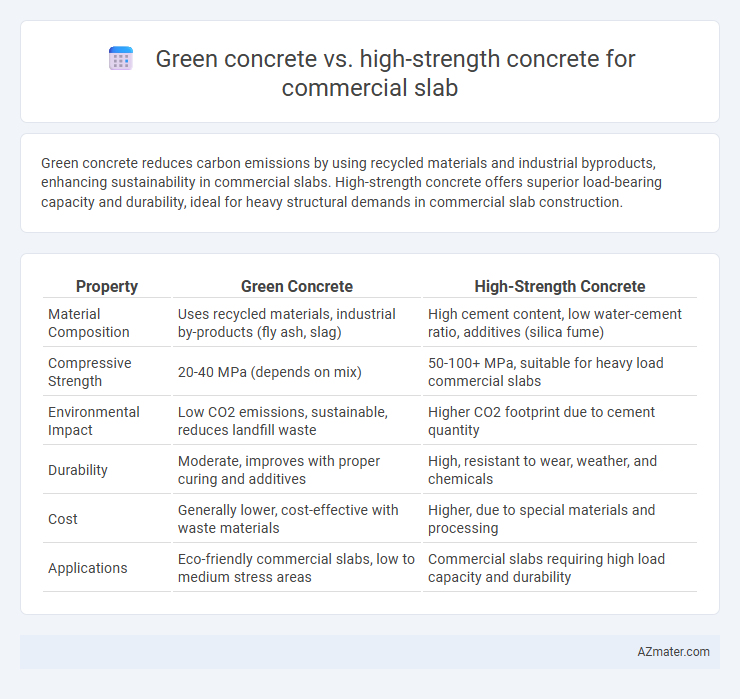Green concrete reduces carbon emissions by using recycled materials and industrial byproducts, enhancing sustainability in commercial slabs. High-strength concrete offers superior load-bearing capacity and durability, ideal for heavy structural demands in commercial slab construction.
Table of Comparison
| Property | Green Concrete | High-Strength Concrete |
|---|---|---|
| Material Composition | Uses recycled materials, industrial by-products (fly ash, slag) | High cement content, low water-cement ratio, additives (silica fume) |
| Compressive Strength | 20-40 MPa (depends on mix) | 50-100+ MPa, suitable for heavy load commercial slabs |
| Environmental Impact | Low CO2 emissions, sustainable, reduces landfill waste | Higher CO2 footprint due to cement quantity |
| Durability | Moderate, improves with proper curing and additives | High, resistant to wear, weather, and chemicals |
| Cost | Generally lower, cost-effective with waste materials | Higher, due to special materials and processing |
| Applications | Eco-friendly commercial slabs, low to medium stress areas | Commercial slabs requiring high load capacity and durability |
Introduction to Green Concrete and High-Strength Concrete
Green concrete incorporates recycled materials and industrial by-products like fly ash and slag to reduce environmental impact while maintaining adequate structural performance for commercial slabs. High-strength concrete achieves compressive strengths typically above 6,000 psi through optimized cementitious mixtures and admixtures, offering superior load-bearing capacity for demanding commercial applications. Selecting between green concrete and high-strength concrete depends on balancing sustainability goals with specific structural requirements in commercial slab design.
Key Material Components and Mix Design
Green concrete for commercial slabs incorporates recycled materials like fly ash, slag, and recycled aggregates, reducing cement content to lower carbon emissions while maintaining durability. High-strength concrete relies on a dense mix of Portland cement, silica fume, and superplasticizers to achieve compressive strengths typically above 6,000 psi, optimizing load-bearing capacity. The mix design of green concrete emphasizes sustainability and resource efficiency, whereas high-strength concrete prioritizes mechanical performance and minimal porosity for structural demands.
Sustainability and Environmental Impact
Green concrete significantly reduces carbon emissions by incorporating recycled materials and industrial byproducts such as fly ash and slag, making it an environmentally sustainable choice for commercial slabs. High-strength concrete typically consumes more energy and natural resources during production, resulting in a higher carbon footprint despite its superior durability and load-bearing capacity. Choosing green concrete for commercial slabs supports sustainable construction practices by minimizing environmental impact while meeting structural performance requirements.
Strength and Structural Performance
Green concrete, typically incorporating recycled materials and industrial by-products, offers adequate compressive strength for many commercial slab applications while enhancing sustainability and reducing carbon footprint. High-strength concrete, characterized by a compressive strength exceeding 6000 psi, delivers superior load-bearing capacity and durability, making it ideal for heavy-duty commercial slabs requiring enhanced structural performance. The choice between green and high-strength concrete depends on project-specific strength requirements, environmental goals, and long-term performance criteria.
Durability and Longevity in Commercial Slabs
Green concrete incorporates recycled materials and industrial by-products, enhancing environmental sustainability while offering comparable durability for commercial slabs. High-strength concrete exhibits superior compressive strength, contributing to enhanced load-bearing capacity and improved longevity under heavy traffic and stress conditions. Both materials ensure extended service life, but high-strength concrete typically provides greater resistance to wear, chemical attack, and environmental degradation in commercial slab applications.
Cost Analysis and Economic Considerations
Green concrete offers cost savings through reduced cement usage and incorporation of industrial by-products like fly ash or slag, lowering both material expenses and environmental impact for commercial slabs. High-strength concrete demands higher cement content and specialized admixtures, increasing initial costs but providing superior durability and load-bearing capacity, which can reduce long-term maintenance expenses. Economic considerations must balance upfront costs against lifecycle benefits, with green concrete favored for sustainability and lower emissions, while high-strength concrete suits projects requiring enhanced structural performance and longevity.
Workability and Construction Challenges
Green concrete offers enhanced workability due to the inclusion of industrial by-products like fly ash and slag, which improve flow and reduce water demand for commercial slabs. High-strength concrete requires careful mix design and placement techniques to address its lower workability and higher risk of shrinkage and cracking during curing. Construction challenges with high-strength concrete often involve stricter quality control and specialized equipment to ensure proper consolidation and durability on commercial slab projects.
Maintenance and Repair Requirements
Green concrete, made with eco-friendly materials and industrial by-products, typically exhibits enhanced durability and lower shrinkage, reducing the frequency of maintenance and repair for commercial slabs. High-strength concrete, designed to withstand significant loads, often requires precise curing and may be more susceptible to cracking if not maintained properly, potentially increasing long-term repair needs. Selecting green concrete can lead to sustainable maintenance practices and cost savings through its self-healing properties and resistance to environmental degradation compared to traditional high-strength concrete.
Code Compliance and Industry Standards
Green concrete for commercial slabs meets ASTM C618 and LEED certification criteria, emphasizing sustainability with lower embodied carbon and recycled materials, ensuring code compliance for environmental regulations. High-strength concrete complies with ACI 318 specifications, offering superior load-bearing capacity and durability critical for commercial slab designs requiring enhanced performance under heavy traffic. Both types adhere to local building codes, but green concrete prioritizes eco-friendly standards while high-strength concrete focuses on structural integrity and safety under industry standards.
Choosing the Right Concrete for Commercial Slab Applications
Green concrete offers enhanced sustainability by incorporating recycled materials and reduced carbon footprint, making it ideal for eco-conscious commercial slab projects. High-strength concrete provides superior load-bearing capacity and durability, essential for heavy-duty slab applications requiring resistance to high traffic and structural demands. Selecting the right concrete depends on balancing environmental goals with performance requirements to ensure longevity and compliance with commercial building standards.

Infographic: Green concrete vs High-strength concrete for Commercial slab
 azmater.com
azmater.com